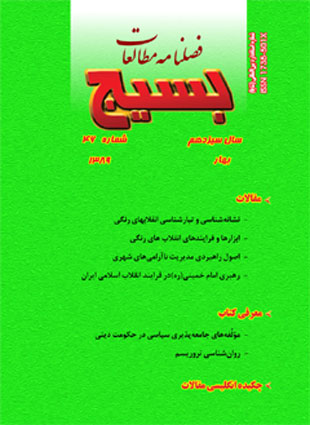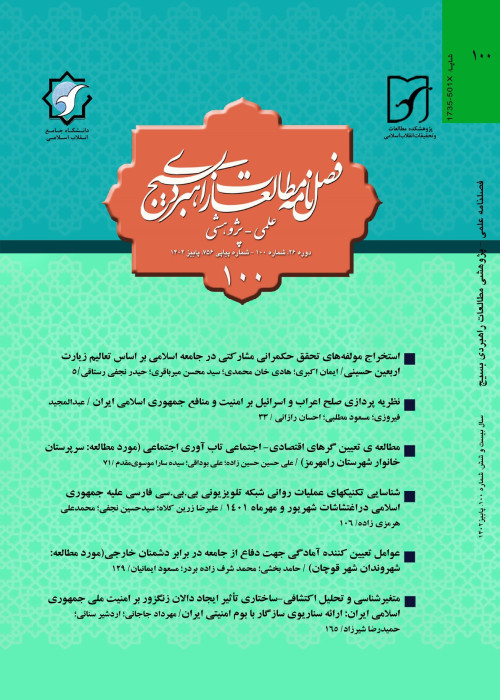فهرست مطالب

نشریه مطالعات راهبردی بسیج
پیاپی 46 (بهار 1389)
- 132 صفحه، بهای روی جلد: 10,000ريال
- تاریخ انتشار: 1389/05/20
- تعداد عناوین: 8
-
صفحه 5
- مقالات
-
صفحه 7تبارشناسی یکی از راه های شناخت پدیده های اجتماعی است. الگوی تبارشناسانه در شرایطی به کار گرفته می شود که جلوه هایی از تغییر، تداوم و برسازی شکلی - معنایی در پدیده ایجاد شود. انقلابهای رنگی، پدیده ای نوظهور در روابط بین الملل می باشند. این امر را می توان در راستای انقلابهای دموکراتیک و در چارچوب موج سوم دموکراسی مورد توجه قرار داد. اگر انقلاب فرانسه که در سال 1789 شکل گرفته را اولین مرحله انقلاب دموکراتیک بدانیم، حوادث کشورهای اروپای شرقی در 200 سال بعد از آن؛ یعنی در سال 1989 را می توان دومین موج انقلاب دموکراتیک دانست. بعد از این مرحله تاریخی، زمینه برای گسترش موجهای مداخله در چارچوب انقلابهای رنگی فراهم شد.
در این مقاله تلاش می شود تا فرایند و تبارشناسی انقلابهای رنگی از طریق بررسی و تحلیل مقایسه ای چنین حوادثی مورد توجه قرار گیرد. حوادث سالهای بعد از فروپاشی نظام دو قطبی، نشان می دهد که فرایندها و نشانه های انقلاب رنگی در راستای تغییر رژیم در کشورهای مورد نظر انجام گرفته است. بررسی حوادث این کشورها بیانگر آن است که جلوه هایی از مشابهت الگویی و رفتاری در این کشورها وجود دارد که می تواند عامل درک سازمان یافته از انقلابهای رنگی و مداخلات آمریکا تلقی شود.
کلیدواژگان: انقلابهای رنگی، مداخله، تغییر رژیم، موج سوم دموکراسی، براندازی نرم -
صفحه 31موضوع انقلابهای رنگی از اواسط دهه 1990 با تغییر در ساختار نظام بین الملل و فروپاشی ساختار دوقطبی مورد توجه قرار گرفت و دستور کار جدیدی را در روابط بین المللی ایجاد کرد که ماهیت فرهنگی – اجتماعی داشت. چنین فرایندی بر اساس ابزارها و فرایندهای رسانه ای – فرهنگی انجام گرفت. در شرایطی که فضای اجتماعی بحرانی می شود یا نشانه هایی از توزیع مجدد قدرت در دستور کار قرار می گیرد، رسانه های بین المللی مبادرت به انتشار ادبیات، مفاهیم و نمادهای تهییجی کرده، زمینه های تغییر در فضای سیاسی کشورهای هدف را فراهم می آورند. بنابر این، انتخابات را می توان به عنوان یکی از اصلی ترین نقاط عطف انقلابهای رنگی در محیط بین الملل دانست که در تمامی آنها رقابت نخبگان سیاسی برای چگونگی اداره نظام سیاسی و توزیع قدرت وجود داشته است. بنابر این، انقلاب رنگی رابطه بین مداخله بین المللی قدرتهای بزرگ با تحولات سیاسی کشورهای دستخوش دگرگونی سیاسی محسوب می شود که مبتنی بر ابزارهای فرهنگی، رسانه ای، تحرک اجتماعی و ترغیب گروه های سیاسی به کنش فراقانونی است. در این مقاله تلاش شده تا فرایندهای انقلاب رنگی در کشورهای مختلف مورد ارزیابی قرار گیرد.
کلیدواژگان: انقلاب رنگی، بحران، انتخابات، ابزارهای رسانه ای، تحرک اجتماعی، افکار عمومی، پیام سیاسی -
صفحه 63مدیریت ناآرامی های شهری را می توان فرآیند به کار گیری جامع، بهینه و سریع منابع در دسترس برای کنترل ناآرامی های داخلی با حداقل خسارت دانست. بی تردید یکی از کارکردهای اصلی مدیریت ناآرامی ها، عبور از وضعیت بحرانی و بازگشت به شرایط عادی در جامعه است. این نوع مدیریت، تلاشی علنی است که عملکرد مدیریت در دید عموم مردم قرار داشته و فرایند اعتمادسازی در جامعه از این منظر حاصل می شود. اثربخش بودن واکنش در برابر ناآرامی ها و موفقیت در برابر آن، مرکز ثقل مدیریت ناآرامی های شهری را تشکیل می دهد که تحقق آن مستلزم شناخت اصول راهبردی آن و برنامه ریزی در مواجهه با آشوبهای خیابانی است. این نوشتار بر آن است اصول مدیریت ناآرامی های شهری را مورد بررسی قرار دهد.
کلیدواژگان: مدیریت، ناآرامی های شهری، اصول، جنگ نرم، تهدید نرم -
صفحه 85نظریه پردازان اجتماعی عنصر رهبری، حضور مردمی و وجود یک ایدئولوژی پویا و دینامیک را برای ظهور قدرت اجتماعی و انقلاب لازم و ضروری می دانند. در انقلاب اسلامی ایران نیز پیوند عمیق و ارادت آگاهانه رهبری و مردم، مهم ترین عامل محرکه انقلاب بود. این ارادت و شیفتگی نه ناشی از جنبه کاریزماتیکی شخصیت امام خمینی(ره)، بلکه برگرفته از پیوند تاریخی مردم مسلمان با مرجعیت شیعه بود که در ابعاد گوناگون حیات انسان ایرانی نمود یافته بود. بنابر این، بر خلاف انقلابهای دیگر، این مردم ایران بودند که عالمانه و آگاهانه رهبر و مقتدای خویش را انتخاب کردند. امام خمینی(ره) نیز در عین مجتهد جامع الشرایط بودن، رهبری با نبوغ ذاتی و صاحب اندیشه و فکر بود که به بسیاری از مفاهیم و مضامین دینی جان تازه ای بخشید و به عکس مشی و منش رهبران انقلابی، عصاره و چکیده اندیشه و عمل خویش را دفاع از حقوق عامه می دانست و تا پایان حیات خویش به خدمتگزاری مردم افتخار می کرد.
کلیدواژگان: امام خمینی (ره)، انقلاب اسلامی، مردم، احیاگری، ولایت فقیه - معرفی و ارزیابی کتاب
-
صفحه 119
-
چکیده انگلیسی مقالاتصفحه 5
-
Page 7Genealogy is a way of acknowledging social phenomena. A genealogic pattern is used in circumstances that signs of change, continuity, semantic and forming improvement appear in the phenomenon. Color revolutions are newfound phenomena in international relations. This can be considered in line with democratic revolutions and in the context of third wave democracy. If we consider the French Revolution in 1789 as the first stage of democratic revolution, the events in Eastern Europe that happened 200 years later, in 1989, could be considered as the second wave of democratic revolution. After this historical stage the basis for democratic interferences was founded in the context of color revolutions.This article tries to consider the process and genealogy of color revolutions through comparative analysis of such events. Consequential events of the bipolar system breakdown shows that processes and signs of color revolutions happened to change the regime in target countries. Reviewing these events indicates signs of similarity in patterns and behaviors in these countries that could serve as an organized factor in perceiving color revolutions and United States interferences.Keywords: Color revolutions, democratic interference, regime change, third wave of democracy, soft overthrow
-
Page 31The issue of “Color Revolutions” was considered in the late 90’s along with changes in the structure of the international system and the bipolar order breakdown, created a new agenda in international relations which had a cultural-social nature. Such a process was done based on cultural-media implements and processes. When social environment goes critical or signs of power redistribution are placed on the agenda, the international media attempts to publish agitated literature, concepts and symbols in order to prepare the way for changes in the political space of target countries. Thus, elections can be considered as one of the major turning points of color revolutions in the international environment, as in all of them there are competitions among political elites for handling the political system and power contribution. Therefore, color revolution is the relationship between the international interference of major authorities and the political transformations of the countries which are subjected to political changes that is based on cultural-media implements, social motivation and encouraging political groups to extra-legal actions. This article attempts to evaluate processes of color revolutions in different countries.Keywords: color revolutions, crisis, elections, media implements, social mobility, public opinion, political message
-
Page 63Managing urban unrests can be considered as the process of a comprehensive, efficient and prompt usage of available sources in order to control civil unrests with minimal damage. Certainly one of the major functions of managing unrests is to overcome the crisis and return to society’s normal status. This type of management is overt which its performance is in the public eye and develops public confidence. Effective and successful backlash against unrests is the essence of this management, and achieving it requires recognition of its principles and proper planning in facing street riots. This article tries to consider principles of managing urban unrests.Keywords: Management, urban unrest, principles, soft war, soft threat
-
Page 85Social doctrinaires believe that the element of leadership, people’s presence, and the existence of a dynamic ideology are crucial for the manifestation of social power and revolution. In the Islamic Revolution of Iran, the deep link and profound devotion existing between the leader and the public was the most essential motivative power of the revolution. Imam Khomeini’s charismatic personality was not the cause of this devotion and captivation, but the historical link between Shia Muslims and authorities was the case which is obvious in different aspects of Iranian life. Thus, unlike other revolutions it was the Iranians who chose their leader consciously and wisely. Imam Khomeini was not only a leading Shia scholar having all the qualifications, but also a leader with an inherent talent, a sage who gave a new meaning to many religious contexts and contents contrary to the policy and manner of other revolutionary leaders, used the gist of his thoughts and actions to defend public rights; and was proud of serving people as long as he lived.Keywords: Imam Khomeini, Islamic Revolution, people, revival, Rule of the Jurist (Vilayat, e Faqih)


